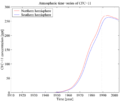Trichlorofluoromethane
This article needs to be updated. (May 2019) |
| |||
| Names | |||
|---|---|---|---|
| Preferred IUPAC name
Trichloro(fluoro)methane | |||
| Other names
Trichlorofluoromethane
Fluorotrichloromethane Fluorochloroform Freon 11 CFC 11 R 11 Arcton 9 Freon 11A Freon 11B Freon HE Freon MF | |||
| Identifiers | |||
3D model (JSmol)
|
|||
| ChEBI | |||
| ChEMBL | |||
| ChemSpider | |||
| ECHA InfoCard | 100.000.812 | ||
| EC Number |
| ||
PubChem CID
|
|||
| RTECS number |
| ||
| UNII | |||
CompTox Dashboard (EPA)
|
|||
| Properties | |||
Chemical formula
|
CCl3F | ||
| Molar mass | 137.36 g·mol−1 | ||
| Appearance | Colorless liquid/gas | ||
| Odor | nearly odorless[1] | ||
| Density | 1.494 g/cm3 | ||
| Melting point | −110.48 °C (−166.86 °F; 162.67 K) | ||
| Boiling point | 23.77 °C (74.79 °F; 296.92 K) | ||
| 1.1 g/L (at 20 °C) | |||
| log P | 2.53 | ||
| Vapor pressure | 89 kPa at 20 °C 131 kPa at 30 °C | ||
| Hazards | |||
| Safety data sheet | See: data page ICSC 0047 | ||
| Flash point | Non-flammable | ||
| Lethal dose or concentration (LD, LC): | |||
LCLo (lowest published)
|
26,200 ppm (rat, 4 hr) 100,000 ppm (rat, 20 min) 100,000 ppm (rat, 2 hr)[2] | ||
| NIOSH (US health exposure limits): | |||
PEL (Permissible)
|
TWA 1000 ppm (5600 mg/m3)[1] | ||
REL (Recommended)
|
C 1000 ppm (5600 mg/m3)[1] | ||
IDLH (Immediate danger)
|
2000 ppm[1] | ||
| Supplementary data page | |||
Structure and
properties |
Refractive index (n), Dielectric constant (εr), etc. | ||
Thermodynamic
data |
Phase behaviour solid–liquid–gas | ||
Spectral data
|
UV, IR, NMR, MS | ||
Except where otherwise noted, data are given for materials in their standard state (at 25 °C [77 °F], 100 kPa). | |||
| Infobox references | |||
Trichlorofluoromethane, also called freon-11, CFC-11, or R-11, is a chlorofluorocarbon (CFC). It is a colorless, faintly ethereal, and sweetish-smelling liquid that boils around room temperature.[3] CFC-11 is a Class 1 ozone-depleting substance which damages Earth's protective stratospheric ozone layer.[4]
Historical use[]
Trichlorofluoromethane was first widely used as a refrigerant. Because of its high boiling point (compared to most refrigerants), it can be used in systems with a low operating pressure, making the mechanical design of such systems less demanding than that of higher-pressure refrigerants R-12 or R-22.
Trichlorofluoromethane is used as a reference compound for fluorine-19 NMR studies.
Trichlorofluoromethane was formerly used in the drinking bird novelty, largely because it has a boiling point of 23.77 °C (74.79 °F). The replacement, dichloromethane, boiling point 39.6 °C (103.3 °F), requires a higher ambient temperature to work.
Prior to the knowledge of the ozone depletion potential of chlorine in refrigerants and other possible harmful effects on the environment, trichlorofluoromethane was sometimes used as a cleaning/rinsing agent for low-pressure systems.[5]
Production moratorium[]
Trichlorofluoromethane was included in the production moratorium agreed in the Montreal Protocol of 1987. It is assigned an ozone depletion potential of 1.0, and U.S. production was ended on January 1, 1996.[4]
Regulatory challenges[]
In 2018, the atmospheric concentration of CFC-11 was noted by researchers to be declining more slowly than expected,[6][7] and it subsequently emerged that it remains in widespread use as a blowing agent for polyurethane foam insulation in the construction industry of China.[8] In 2021 researchers announced that emissions declined by 20,000 U.S. tons from 2018 to 2019, which mostly reversed the previous spike in emissions.[9]
Gallery[]

CFC-11 measured by the Advanced Global Atmospheric Gases Experiment (AGAGE) in the lower atmosphere (troposphere) at stations around the world. Abundances are given as pollution free monthly mean mole fractions in parts-per-trillion.

Hemispheric and Global mean concentrations of CFC-11 (NOAA/ESRL)

Time-series of atmospheric concentrations of CFC-11 (Walker et al., 2000)

"Present day" (1990s) sea surface CFC-11 concentration

"Present day" (1990s) CFC-11 oceanic vertical inventory
See also[]
- List of refrigerants
- IPCC list of greenhouse gases
References[]
- ^ Jump up to: a b c d NIOSH Pocket Guide to Chemical Hazards. "#0290". National Institute for Occupational Safety and Health (NIOSH).
- ^ "Fluorotrichloromethane". Immediately Dangerous to Life or Health Concentrations (IDLH). National Institute for Occupational Safety and Health (NIOSH).
- ^ Siegemund, Günter; Schwertfeger, Werner; Feiring, Andrew; Smart, Bruce; Behr, Fred; Vogel, Herward; McKusick, Blaine (2002). "Fluorine Compounds, Organic". Ullmann's Encyclopedia of Industrial Chemistry. Weinheim: Wiley-VCH. doi:10.1002/14356007.a11_349.
- ^ Jump up to: a b "International Treaties and Cooperation about the Protection of the Stratospheric Ozone Layer". U.S. Environmental Protection Agency. 15 July 2015. Retrieved 2021-02-14.
- ^ "R-10 ,R-11 ,R-12 GASES - ملتقى التبريد والتكييف HVACafe". ملتقى التبريد والتكييف HVACafe (in Arabic). 2017-05-25. Retrieved 2018-05-18.
- ^ Montzka, S.A.; Dutton, G.S.; Yu, P.; et al. (2018). "An unexpected and persistent increase in global emissions of ozone-depleting CFC-11". Nature. Springer Nature. 557 (7705): 413–417. Bibcode:2018Natur.557..413M. doi:10.1038/s41586-018-0106-2. hdl:1983/fd5eaf00-34b1-4689-9f23-410a54182b61. PMID 29769666. S2CID 21705434.CS1 maint: multiple names: authors list (link)
- ^ Johnson, Scott (5 May 2018). "It seems someone is producing a banned ozone-depleting chemical again". Ars Technica. Retrieved 18 October 2018.
Decline of CFC-11 has slowed in recent years, pointing to a renewed source
- ^ McGrath, Matt (9 July 2018). "China 'home foam' gas key to ozone mystery". BBC News. Retrieved 9 July 2018.
- ^ Jennifer Chu (2021-02-10). "Reductions in CFC-11 emissions put ozone recovery back on track". MIT News.
External links[]
- CFC-11 NOAA/ESRL Global measurements
- Public health goal for trichlorofluoromethane in drinking water
- Names at webbook.nist.gov
- Data sheet at speclab.com
- International Chemical Safety Card 0047
- NIOSH Pocket Guide to Chemical Hazards. "#0290". National Institute for Occupational Safety and Health (NIOSH).
- Phase change data at webbook.nist.gov
- Thermochemistry data at chemnet.ru
- ChemSub Online: Trichlorofluoromethane - CFC-11
- Halomethanes
- Chlorofluorocarbons
- Refrigerants
- Greenhouse gases






